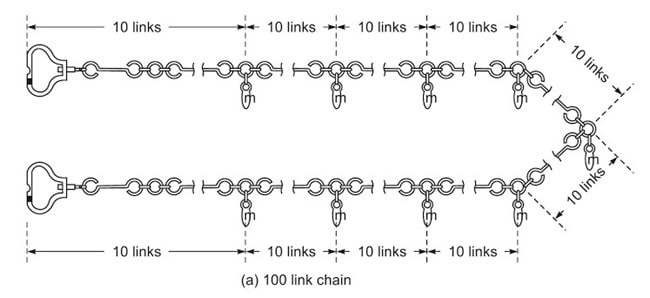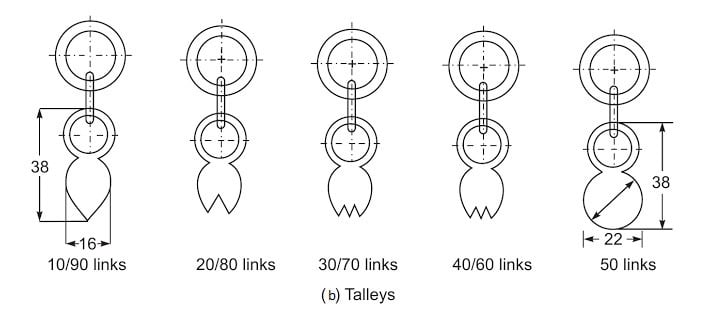1.Chain
2.Ranging Rods and Ranging Poles
3.Offset Road
4.Plumb Bob
5.Arrows
6.Pegs
1.Chain
Chains are the measuring instrument used in surveying formed by the 100 links of 4mm galvanized mild steel wire. These links are joined by 3 circular or oval wire rings. These rings provide the flexibility to the chains.
Every aspect of the life requires some measuring units. Measurements are used to do the work precisely and accurately. Let it be from kitchen to office, everywhere measurements are used. So as in engineering calculation or measurements holds a very greater role in construction or surveying or any other aspect.
There are various units of measurements such as meters, centimeters, feets, inches, acre, yards and the list goes on. Same as units there are various instrument used in the measurements of any entity. One of the instruments used in measurement are chains.
Parts of Chains used in Surveying
The chain consists of many small parts used for handling or reading the measurements.


- At the ends chain is provided with brass handle with swivel joint so that it can be easy to roll or unroll the chain without twisting and knots.
- At every 10th link is provided with a tally of one teeth, 20th link with a tally of two teeth and so on till 40th link. This is provided for the easy reading of measurements.
- At the center of the chain is provided with a circular talley used for easy reading.
Types of Chains used in Surveying
Depending upon the length of the chain, these are divide into following types,- Metric chains
- Steel band or Band chain
- Gunter’s chain or surveyor’s chain
- Engineer’s chain
- Revenue chain
A. Metric chains
Metric chains are the most commonly used chain in India. These types of chains comes in many lengths such as 5, 10, 20 and 30 meters. Most commonly used is 20m chain. Tallies are provided at every 2m of the chain for quick reading. Every link of this type of chain is 0.2m. The total length of the chain is marked on the brass handle at the ends.B. Steel band or Band chain
These types of chain consist of a long narrow strip of steel of uniform width of 12 to 16 mm and thickness of 0.3 to 0.6 mm. this chain is divides by brass studs at every 20cm or instead of brass studs, band chain may have graduated engraving as centimeter.For easy use and workability band chains are wound on steel crosses or metal reels from which they can be easily unrolled. These steel bands are available in 20m and 30m length and the width of about 12-16mm.C. Gunter’s chain or surveyor’s chain
Gunter chain comes in standard 66ft. These chain consists of 100links, each link being 0.66ft or 7.92inches. The length 66ft is selected because it is convenient in land measurements.- 10 square Gunter’s chains = 1 Acre10 Gunter chains = 1 Furlong80 Gunter chains = 1 mile
D. Engineer’s chain
This chain comes in 100ft length. Its consist of 100 links each link being 1ft long. At every 10 links a brass ring or tags are provided for indication of 10 links. Readings are taken in feet and decimal.E. Revenue Chain
The standard size of this type of chain is 33ft. The number of links are 16, each link being 2 ft. This chain is commonly used in cadastral survey.
ft. This chain is commonly used in cadastral survey.
2.Ranging Rods and Ranging Poles
For ranging intermediate points along the line to be measured, ranging rods and ranging poles are used.
Ranging rods are 2 to 3 m long and are made of hard wood. They are provided with iron shoe at one end.
They are usually circular in section with 30 mm diameter and are painted with 200 mm colour bands of red and white or with black and white. If distance is more than 200 m, for clear visibility they may be provided with multicoloured flags at their top. The ranging rods are occasionally used to measure
short distances since they are painted with alternate colour of band 200 mm..
3.Offset Road
Similar to the ranging rod, they are usually 3 m long and is divided into parts each 0.2 m length. Top is an provided with an open ring for puling or pushing the chain through a hedge. It has two short narrow vertical slots. It is used for aligning short offsets.
4.Plumb Bob
The plumb bob is required when measuring the distance along slopes in order to transfer points to the ground. It is also used for testing the verticality of ranging poles.
5.Arrows
When the length of the line to be measured is more than a chain length, there is need to mark the end of the chain length. Arrows are used for this purpose. A typical arrow is shown in Fig. 12.5. Arrows are made up of 4 mm diametered steel wire with one end sharpened and other end bent into a loop. Length of an arrow is approximately 400 mm.
6.Pegs
Wooden pegs are used in measuring a length of a line to mark the end points of the line. The pegs are made of hard wood of 25 mm × 25 mm section, 150 mm long with one end tapered as shown in Fig. 12.6. When driven in ground to mark station points they project about 40 mm.











No comments:
Post a Comment